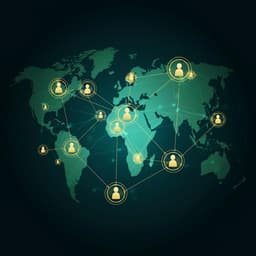
Environmental Studies and Forestry
Exploring the diversity of conceptualizations of nature in East and South-East Asia
L. Droz, H. Chen, et al.
This research delves into the intricate and varied meanings of 'nature' in several East and South-East Asian languages, uncovering the subtleties lost in translation. Conducted by a diverse group of authors, it calls for broader representation of these perspectives in global sustainability efforts.
~3 min • Beginner • English
Introduction
The paper addresses how the English concept of “nature,” widely used in global environmental science and policy (e.g., “Nature’s Contributions to People,” #ForNature campaigns), carries historically contingent assumptions and dichotomies (nature/culture, natural/artificial, human/nature) that may not translate across languages and worldviews. The authors hypothesize linguistic relativity in environmental governance: language shapes thought and decision-making, and connotations embedded in terms for “nature” influence policy design and implementation. They note a strong English-language bias in global assessments and the risk of imposing a narrow, Western-influenced notion of nature onto diverse cultural contexts. The study aims to make accessible to English readers a panorama of selected conceptualizations of “nature” in East and South-East Asian languages, revealing nuances and potential mismatches that matter for sustainability policy and practice.
Literature Review
The paper situates its inquiry within debates on linguistic relativity (Sapir-Whorf) and decision-making biases when using foreign languages, arguing that connotations of terms (like “nature”) affect environmental governance. It references the dominance of English in global assessments (e.g., IPBES source language bias) and the emergence of terms such as “Nature’s Contributions to People.” It surveys the Western genealogy of “nature” from Greek phusis and Latin natura through Christian and scientific influences to modern narrow dichotomies that often exclude humans and culture. Prior work emphasizes the need for pluralism in biodiversity governance and cautions against universalist framings, highlighting that diverse conceptualizations of nature can improve inclusivity and legitimacy in policy processes.
Methodology
The study focuses on East Asia (China, Hong Kong, Macau, Japan, Mongolia, North Korea, South Korea, Taiwan) and South-East Asia (Brunei, Cambodia, East Timor, Indonesia, Laos, Malaysia, Myanmar, Philippines, Singapore, Thailand, Vietnam) per UNSD. It reviews the idea of “nature” in eleven languages: Chinese, Japanese, Vietnamese, Filipino/Tagalog, Cebuano, Lumad, Indonesian, Burmese, Nepali, Khmer, and Mongolian. Native or local environmental humanities experts were recruited via the Network of Asian Environmental Philosophy to complete a structured form or write narrative contributions on meanings, nuances, and origins of words for “nature” in their languages. Contributors conducted literature reviews in their primary languages and advised on scope and limitations. Collaborative refinement occurred through three online workshops (July 29, 2021; October 1, 2021; November 17, 2021); 12 experts attended at least one, and two others contributed individually. The approach varied by context: historical-philological analyses for traditions with rich etymological scholarship (e.g., Chinese, Japanese) and anthropological/discourse-analytic methods (interviews, legal discourse, linguistic anthropology) where formal literature is limited (e.g., Indonesian, Filipino, Vietnamese, Indigenous languages). Primary sources in the target languages were prioritized, complemented by secondary sources in other languages. Practical constraints included limited access to resources and unreliable internet in some locations. Policy and legal usages of the narrow “nature” concept served as a comparative starting point across languages.
Key Findings
- A central finding is a mismatch between the globally homogenized, narrow usage of “nature” in science, engineering, economics, and policy (often excluding humans and culture and organized around dichotomies) and the diverse, context-dependent usages in daily life, politics, and culture across East and South-East Asian languages.
- Many languages integrate older meanings alongside modern, policy-driven senses, leading to overlapping or layered connotations. For example, Japanese shizen/jinen historically conveyed spontaneity or self-suchness but now also translates the Western environmental sense; Chinese zìrán functions differently as noun vs. adjective/adverb; Vietnamese distinguishes Thiên nhiên (environmental nature) and Tự nhiên (also intrinsic nature/character).
- No single term in many languages neatly captures “everything non-human”; distinctions between living/non-living and material/spiritual beings vary and often diverge from Western dichotomies. Humans are sometimes included in “nature” (e.g., Mongolian baigali; Nepali prakriti in some senses), and spiritual worlds may be coextensive with material nature (e.g., Burmese and Khmer Buddhist cosmologies; Indonesian alam includes natural and supra-natural realms in some uses; Lumad cosmology treats land as sacred and life-giving).
- Recurrent cross-linguistic themes include: spontaneity or “as it is” (jinen; Burmese thabawa), layered cosmologies (material, animal, phenomenal/gods/spirits), and locally specific milieu concepts (e.g., Japanese fūdo). These reveal bridges between humans and non-humans rather than rigid separations.
- Language-specific insights (non-exhaustive):
• Chinese: zìrán (如今 noun often excludes humans; adjective/adverb retains ancient sense of self-so/so-of-itself); tiāndì and wànwù offer alternative scopes; ancient usage included humans and emphasized freedom from external interference.
• Japanese: shizen/jinen layers spontaneous state, non-artificiality, and unpredictability; kankyō for environment; traditional expressions enumerate mountains/rivers/plants/trees.
• Vietnamese: Thiên nhiên (environmental nature); Tự nhiên (also intrinsic nature). Kinh worldview emphasizes harmony among Heaven, Earth, and Humanity.
• Mongolian: baigali includes humans within nature; Tengri and Mother Earth (Etügen) frame reverence and restraint; “orchin” used to specify surroundings sans humans.
• Nepali: prakriti as original substance/form (Sāṃkhya), initiating evolution with purusha; vatavaran for environment; human/non-human divide less salient than caste and spiritual categories.
• Burmese: thabawa (“as it is”), with three worlds—material, animal, phenomenal; natural environment comprises material and animal worlds, excluding humans; partwonkyin denotes surroundings and includes humans, with subtypes (natural, human, social environments).
• Khmer: thommocheat denotes all that is not human-made; nature seen as a gift; protected areas free from humans are viewed as foreign concepts by many.
• Indonesian: alam denotes what exists in skies and earth; Arabic/Malay roots; can connote minimal human intervention and include supra-natural realms (alam gaib). Governance uses lingkungan hidup for (living) environment.
• Filipino/Tagalog: kalikasan (“together with nature,” “life sources”); Cebuano: kinaiyahan linked to human traits and reciprocity; Lumad terms conceive land as sacred and life itself.
- Empirical and contextual notes: strong English-language bias in global assessments; widespread use of #ForNature slogans; 12 experts participated across workshops; 11 languages analyzed.
- Policy-relevant insight: The narrow, human-excluding concept of nature is neither universal nor always appropriate; translation can conceal cosmological, ontological, and ethical mismatches affecting policy acceptance and effectiveness.
Discussion
The findings support the hypothesis that language shapes environmental thought and decisions: divergent meanings and connotations of “nature” can hinder mutual understanding and lead to inappropriate policy transfers. The common, narrow English framing is useful for international dialogue but masks local ontologies where humans, non-humans, and spiritual entities are entangled. Therefore, environmental governance should balance a shared, necessarily ambiguous vocabulary with deliberate, context-specific interpretation and adaptation. Recognizing layered cosmologies and inclusive conceptions of nature may avoid conflicts (e.g., conservation that excludes people) and enhance policy legitimacy and effectiveness. The study argues for broader inclusion of linguistic and cultural traditions—beyond Indigenous/local knowledge alone—at the science-policy interface, engaging humanities scholars and non-English sources to translate and mediate conceptual frameworks. Such pluralism can lead to better sustainability decisions and more equitable governance.
Conclusion
The paper presents a non-exhaustive panorama of conceptualizations of “nature” across East and South-East Asia, revealing that translations often conceal deeper cosmological, ontological, and ethical differences. Rather than enforcing a narrow, human-excluding concept, negotiations and policies should remain open to plural conceptual frames. Two primary recommendations follow: (1) include diverse voices and scholars with expertise in non-English traditions in global sustainability assessments and reports; (2) design solutions and policies grounded in local conceptual and cultural frames. Accounting for conceptual diversity can improve decision quality, policy acceptability, and implementation effectiveness across contexts, and invites future, more extensive cross-cultural research.
Limitations
The study is not exhaustive and does not provide in-depth historical-philosophical analyses for each language; scope and depth are constrained by the breadth of traditions covered. Methodological approaches differ across contexts due to varying scholarly traditions and available literature. Some contributors faced restricted access to resources and unreliable internet, potentially limiting source breadth. The work relies on expert elicitation and literature reviews rather than quantitative linguistic analysis, and no datasets were generated.
Related Publications
Explore these studies to deepen your understanding of the subject.







